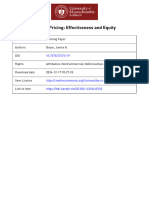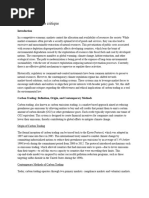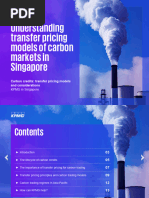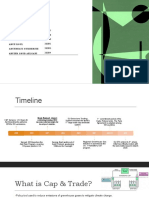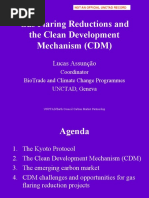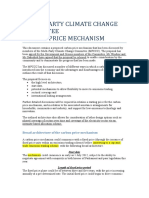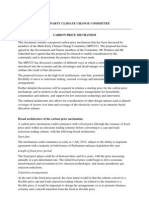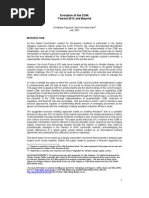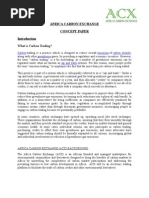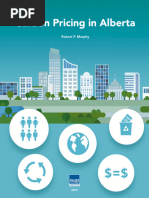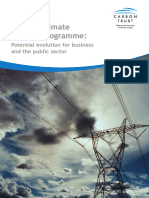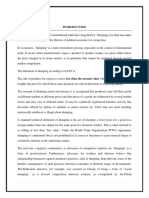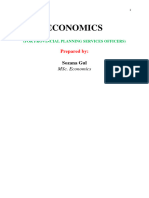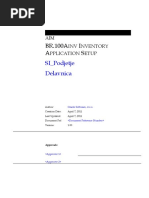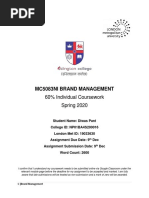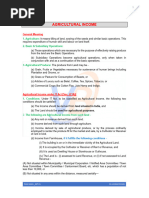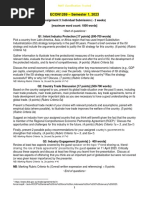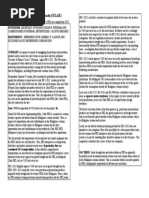Carbon Trading in South Africa:: Providing Flexibility or Escape Route?
Carbon Trading in South Africa:: Providing Flexibility or Escape Route?
Uploaded by
rosco kleinCopyright:
Available Formats
Carbon Trading in South Africa:: Providing Flexibility or Escape Route?
Carbon Trading in South Africa:: Providing Flexibility or Escape Route?
Uploaded by
rosco kleinOriginal Title
Copyright
Available Formats
Share this document
Did you find this document useful?
Is this content inappropriate?
Copyright:
Available Formats
Carbon Trading in South Africa:: Providing Flexibility or Escape Route?
Carbon Trading in South Africa:: Providing Flexibility or Escape Route?
Uploaded by
rosco kleinCopyright:
Available Formats
Low-carbon policy inputs
POLICY
BRIEF
ZA
2018
Carbon trading in South Africa:
providing flexibility or escape route?
SUMMARY Economists often describe climate
change as the greatest market failure.
They argue that putting a price on carbon
is the most cost-effective mechanism to
reduce greenhouse gas (GHG) emissions and thereby
address climate change.1 Once priced, the possibility
of trading carbon arises.2
This paper investigates whether the inclusion of carbon trading in South Africa’s
Mitigation System provides flexibility to the major emitters in reducing their
emissions, or serves as an escape route from achieving meaningful GHG
emissions reductions. We present both theoretical and practical challenges that
can reduce the effectiveness of carbon trading as a climate change mitigation tool in
the South African context.
1 South Africa’s Climate Change Mitigation System
The Department of Environmental Affairs (DEA) is developing a post-
2020 Climate Change Mitigation System that aims to create the necessary
framework for the country to meet its domestic mitigation ambitions and
international commitments. Carbon budgets are a feature of the Mitigation
System being developed. They are allowances to emit a certain amount of
greenhouse gases, to be allocated to those entities required to report their
greenhouse gas emissions.
Carbon trading is under consideration as a flexibility mechanism
in the Mitigation System. Proposed is an absolute baseline-and-credit
trading scheme. Entities emitting less than their carbon budget could sell
carbon credits.
In parallel, Treasury is putting a carbon tax in place at a proposed rate of
R120/tCO2e before up to 95% rebates are allowed. This includes allowing up
to 10% of a company’s tax liability to be reduced through carbon offsets.
2 The theory
Economists argue that putting a price on carbon is the most cost-
effective mechanism to reduce carbon emissions, and to address
climate change. Trading carbon emissions allows sectors with poor
mitigation potential to fund deeper emissions reductions in sectors with
better mitigation potential. It therefore helps to achieve overall emissions
reductions across the economy at least cost.
1 Carbon Pricing Leadership Coalition (CPLC), 2017. Report of the high-level commission on carbon
prices. International Bank for Reconstruction and Development and International Development
Association/The World Bank. Available at: https://www.carbonpricingleadership.org/report-of-the-
highlevel-commission-on-carbon-prices/.
2 Greenhouse gases (GHG) are the gases that cause climate change. To be able to compare their
global warming effect, they are converted to ‘carbon dioxide equivalent’, CO2e. Shorthand, they are
collectively referred to as ‘carbon emissions’. They are measured in tonnes, so we write tCO2e.
Page 2 | Carbon trading in South Africa: providing flexibility or escape route?
Low-carbon policy inputs
3 The reality
The international experience with implementing carbon trading
has seen varying degrees of success. The global carbon market has
failed to account for all the external costs of carbon emissions and has
therefore failed to deliver economic efficiency and sustainable behaviour.
The European Union Emissions Trading Scheme (EU ETS), for example,
has failed to achieve adequate emissions reductions commensurate with
the targets required by science. This is because of an historically weak
carbon price signal, resulting from weak demand for carbon permits and
over-allocation of free emissions permits.
4 WWF-SA position
We strongly recommend that carbon trading be excluded from
South Africa’s Mitigation System, because:
The South African economy is highly concentrated, even monopolistic in some
sectors, and thus not suitable for a carbon trading system.
It is welcomed that firms producing electricity for sale are excluded from the
carbon trading system, and the emissions of parastatal Eskom can be managed
through electricity supply policy. Since electricity generation accounts for the
Contents bulk of South Africa’s emissions, that leaves a limited spectrum of emissions to
be covered by the carbon trading system. The result could be low demand for
Summary trading and risks market failure.
2 There is high emissions uncertainty because of high flexibility in the medium to
Role of carbon long-run in the proposed carbon budgets.
pricing in carbon The carbon tax rate will act as an effective carbon price ceiling in the carbon
trading credits marketplace. The currently proposed carbon tax of R120/tCO 2e is too
4 low to drive mitigation action.
Carbon markets The carbon tax must at least be enforced as a regulatory carbon credit price floor
and carbon to ensure price stability and prevent carbon credit prices from dropping
trading – in to insufficiently low levels as was the case in the EU ETS.3
theory
The over-determination of flexibility mechanisms within the carbon tax
6
design and Mitigation System presents loopholes for firms to avoid meaningful
Carbon trading emissions reductions, and is likely to result in perverse outcomes for the
in the Mitigation economy and climate change mitigation.
System Establishing and running a carbon trading system will carry a significant
9 administrative burden.
International
experience Should carbon trading be included in the South African Mitigation System, it is
11 recommended that it meet the criteria outlined in the table entitled ‘Necessary
conditions for using cooperative approaches that involve the use of ITMOs’ in this
Ensuring
paper. In addition, the weak price signal provided by the carbon tax at R120/tCO2e,
an effective
can at best be used only to provide a price floor and therefore the rate needs to be
carbon trading
increased substantially.
mechanism
15
WWF-SA position
17
3 CPLC, 2017.
Carbon trading in South Africa: providing flexibility or escape route? | Page 3
ROLE OF CARBON PRICING
IN CARBON TRADING
Within a competitive market economy, economic
actors make decisions based on the price of goods
or services. We talk of a price signal influencing
these decisions for the efficient allocation of scarce
resources.4 However, if there are external costs
in the production or consumption of a particular
good that are imposed onto a third party, which
producers and/or consumers have not taken into
account and internalised in the price, then the free
market will fail.5
Unregulated production of carbon emissions is an example of this. Unregulated
carbon emissions impose a significant external cost onto the global society, for
example in the form of climate change and health impacts. When carbon-intensive
goods are produced (or consumed) without factoring in the cost of the carbon
emissions to society and the economy as a whole, neither the producer nor the
consumer pays for the damages caused by carbon emissions. This results in a market
failure leading to climate change.6
THE SOCIAL COST Government interventions in the form of carbon pricing policies are identified
as effective and cost-efficient tools to correct such market failure and to mitigate
OF CARBON climate change.7 Establishing a carbon price provides the necessary price signal
for producers and consumers to internalise the social cost of carbon emissions
“the present value by increasing the price of carbon-intensive goods. This is expected to encourage
of future damages a behavioural change in producers and consumers to move towards low-carbon
alternatives, such as renewable energy generation and energy-efficient technologies.8
associated with an
incremental increase An important condition to ensure the efficacy of the carbon price is that it should
in carbon emissions (or be set at a level that is high enough to encourage meaningful behavioural change
to collectively keep average global warming well below 2 °C in order to avoid
carbon equivalent) in a catastrophic climate change.9
particular year”
4 National Treasury (NT), 2013. Carbon Tax Policy Paper – Reducing greenhouse gas emissions and
facilitating the transition to a green economy. Pretoria: Republic of South Africa. National Treasury.
Available at: http://www.treasury.gov.za/public%20comments/Carbon%20Tax%20Policy%20Paper%20
2013.pdf.
5 Kaufam, N., Obeiter, M. & Krause, E., 2016. Putting a price on carbon: reducing emissions. Available
at: https://www.wri.org/sites/default/files/Putting_a_Price_on_Carbon_Emissions.pdf.
6 Kaufam, et al., 2016.
7 World Bank and Ecofys, 2018. State and trends of carbon pricing 2018, Washington, DC: World Bank.
8 NT, 2013; Kaufam, et al., 2016.
9 OECD, 2015. Adapting transport policy to climate change: carbon valuation, risk and uncertainty.
Available at: http://dx.doi.org/10.1787/9789282107928-en.
Page 4 | Carbon trading in South Africa: providing flexibility or escape route?
Low-carbon policy inputs
GLOBAL CARBON Carbon pricing: advantages and disadvantages10
MARKET Advantages Disadvantages
the various national and Behaviour change:
Encourages behavioural change all along
Inadequate price:
An ineffective carbon price can have
regional carbon trading supply and consumption chains towards a perverse effects on marginalised
systems are collectively
low-carbon economy by establishing the communities. For example, weak carbon
necessary price signal to correct a market prices may lead to higher electricity prices,
referred to as the global
failure. with limited reductions in carbon emissions.
This has a relatively greater impact on
carbon market the poor without the benefit of meaningful
emissions reductions.
Cost-effective emissions reductions: Unintended consequences:
ABSOLUTE Encourages the most cost-effective
emissions reductions wherever and however
While carbon pricing may successfully
incentivise emissions reductions, the
BASELINE-AND-CREDIT they can be achieved across the economy. mitigation initiatives that are actioned can
have harmful impacts. For example, the
TRADING SCHEME UN’s carbon credit programme has driven
the increased production of a coolant with
harmful waste gas by-products.
carbon credits earned Generates government revenue: Risk of losing international
from reducing carbon Can generate additional government
revenue that can be reinvested back into
competitiveness:
In the absence of global carbon prices,
emissions below an the economy for further climate change countries with carbon pricing policies may
mitigation or for minimising negative impacts risk losing international competitiveness
absolute emissions of climate change policy on marginalised in the short-term. Once the cost of carbon
ceiling can be traded
communities. is included, the price of carbon-intensive
goods may go up, thus leading to a loss in
with firms that price competitiveness for those goods and
markets.
exceed their absolute Transparent and efficient:
emissions ceiling Carbon pricing is more transparent and
administratively efficient than subsidies,
which are often subject to political
interference.
10 Based on Kaufam, et al., 2016; NT, 2013; Markoff, 2012.
Carbon trading in South Africa: providing flexibility or escape route? | Page 5
CARBON MARKETS AND CARBON
TRADING –– IN THEORY
EMISSIONS CAP / A carbon price can be determined by two policy
CARBON BUDGET instruments – a carbon tax and/or a carbon market.
quantity-based A carbon tax is a price that government charges entities for every tonne of CO2e
instruments used to emitted. A carbon market is where demand and supply forces establish the price
as happens in the market for any other commodity. Within a carbon market, an
define an upper limit entity’s emissions are capped or limited, in line with the overall emission reduction
for carbon emissions commitment of the country or region. If an entity emits less than its limit, the
unused allowance is converted into an equivalent amount of tradable allowances or
credits.11
EMISSIONS INTENSITY
BENCHMARK Depending on the policy design, carbon emissions can be restricted through the
implementation of a hard emissions cap, an absolute emissions reduction target,
process-based emissions intensity benchmark, or through carbon budgets. Imposing a restriction
instrument used to on carbon emissions converts it into a scarce resource which can be traded like
any other commodity.12 Entities that emit below their cap, benchmark, or allocated
define expected carbon budget, are eligible to trade their unused carbon allowances or credits
efficiency in a (‘carbon space’) to other entities that emit over their emissions allowance.
production process
Existing global carbon prices
In 2018, 45 national and 25 sub-national jurisdictions had established a carbon price,
covering approximately 20% of global carbon emissions.13 Existing carbon prices within
various carbon trading systems globally, range from R15/tCO2e to R352/tCO2e. On the
other hand, existing carbon prices introduced as a carbon tax, range from R15/tCO2e to
R2 056/tCO2e.14
The decision to either reduce emissions through mitigation or to trade emissions
credits is up to the individual entity, and is influenced by the carbon price and
the company’s Marginal Cost of Mitigation (MCM). MCM is the cost incurred for
achieving an additional reduction of 1 tCO2e. If it is cheaper for the entity to
mitigate instead of purchasing excess carbon space, then it will increase its
mitigation effort to a point where its MCM is equal to the carbon price, indicated
by point A ii in the graph on the next page.
11 Vivid Economics, DNA Economics & Tyler, E., 2016. Integrating the carbon tax and carbon budgets in
South Africa. Available at: https://www.caia.co.za/wp-content/uploads/2016/09/14-july-2016-alignment.
pdf.
12 Cloete, et al., 2013.
13 World Bank and Ecofys, 2018.
14 Haites, E., 2018. Carbon taxes and greenhouse gas emissions trading systems: what have we learned?
Climate Policy, 18(8): 955–966.
Page 6 | Carbon trading in South Africa: providing flexibility or escape route?
Low-carbon policy inputs
Carbon trading in theory: MCM vs carbon price15
Carbon
price MCM Firm B
R800/tCO2e Bi MCM Firm A
R570/tCO2e
Aii
R80/tCO2e Ai
Me1 Me2 Mitigation effort
Carbon trading in theory
Literature indicates that an effective carbon price lies in the range R570–R1140/tCO2e.16
Let us choose R570/tCO2e as the carbon price for illustrative purposes.
Suppose that Firm A faces a lower MCM (R80/tCO2e) relative to the carbon price. It will
therefore increase its mitigation efforts from Me1 to Me2 until the MCM is equal to the
carbon price (indicated by the shift from point Ai to Aii).
In contrast, Firm B, faces a higher MCM (R800/tCO2e) relative to the carbon price. It will
therefore purchase excess carbon space from Firm A at a relatively cheaper price of
R855/tCO2e, resulting in an overall reduction of emissions at the lowest cost across the
economy. Thus, carbon trading, in theory, can serve as the most economically-efficient
mitigation instrument.
Some economists regard carbon trading as a cost-effective and economically-
efficient mitigation instrument, that achieves greater emissions reductions across
the economy at the lowest cost to society (per unit of CO2e) relative to other policy
instruments.17 In reality this may not be the case, as a trading system may only cover
sectors that provide easy mitigation opportunities18 – referred to as the low-hanging
fruits in literature. In addition, a carbon tax is simpler to administer and, on average,
provides a stronger carbon price relative to a free carbon market where the carbon
price is left to demand and supply forces.19
15 The Climate Reality Project, 2017. Handbook on Carbon Pricing Instruments.Available at: https://www.
climaterealityproject.org/sites/climaterealityproject.org/files/HandbookonCarbonFinancing_Final_
May16.pdf.
16 CPLC, 2017
17 Vivid Economics, DNA Economics & Tyler, E., 2016. Integrating the carbon tax and carbon budgets in
South Africa. Available at: https://www.caia.co.za/wp-content/uploads/2016/09/14-july-2016-alignment.
pdf.
18 Narassimhan, E., Gallagher, K., Koester, S. & Alejo, J., 2018. Carbon pricing in practice: a review of
existing emissions trading systems. Climate Policy, 18(8): 967–991.
19 Haites, E., 2018. Carbon taxes and greenhouse gas emissions trading systems: what have we learned?
Climate Policy, 18(8): 955–966.
Carbon trading in South Africa: providing flexibility or escape route? | Page 7
Carbon trading: advantages and disadvantages20
Advantages Disadvantages
Emissions certainty: Price uncertainty and volatility:
Providing an absolute emissions quantum In a free carbon market, the carbon price is
cap creates certainty in the level of determined by market dynamics, which can
emissions reductions that can be achieved lead to uncertainty, price volatility (or market
through carbon trading mechanisms. fluctuations), and a weak carbon price.
Cost-effectiveness and economic High administrative and transaction
efficiency: costs:
Trading carbon emissions should allow Conducting background research, allocating
sectors with better mitigation potential to allowances, establishing an emissions cap
recoup the cost of their mitigation initiatives or emissions intensity benchmark, and
by selling the emissions reduction credits facilitating carbon trading is administratively
that they have achieved. This can make burdensome, operationally complex, and
such initiatives financially viable. Therefore, results in relatively high transaction costs.
at the economy-wide level, emissions
reductions can be achieved at the least-cost
options.
Environmental effectiveness: Environmentally ineffective:
Assuming there is a high enough carbon Market forces can drive the carbon price
price, carbon trading may incentivise down to ineffective/weak levels. The weak
companies to do extra emissions reductions price signal fails to provide an incentive to
(below emissions caps or carbon budgets) drive behavioural change towards lower-
than they might otherwise, because these carbon alternatives and reduced emissions.
emissions reductions can be traded.
Turning past high emissions into an
asset:
In South Africa, the method for allocating
carbon budgets will start with past levels
of emissions as the baseline. Companies
with high past emissions that are able to do
substantial emissions reductions will thus
get the benefit of turning past emissions
into an asset in the form of tradable carbon
credits. The social cost of carbon already
paid by others in the economy becomes a
double financial reward to the high emitter.
20 Based on Vivid Economics, et al., 2016.
Page 8 | Carbon trading in South Africa: providing flexibility or escape route?
Low-carbon policy inputs
CARBON TRADING IN THE
MITIGATION SYSTEM
The proposed post-2020 Mitigation System includes
mandatory carbon budgets to be allocated to
companies and other entities. These budgets are a
maximum amount of emissions that the entity is
allowed to emit.
It is envisaged that a company can participate in the setting of its budget, and its
historical levels of emissions will be taken into account. The only time a company’s
carbon budget will be managed against the country’s overall emissions targets is
when the aggregate of all budgets exceeds the overarching targets. In this case all
carbon budgets will be reduced pro rata.
In parallel, Treasury is putting a carbon tax in place at a proposed rate of
R120/tCO2e before up to 95% rebates are allowed, which includes allowing up to 10%
of a company’s tax liability to be reduced through carbon offsets.21
In the face of lobbying by high emitters, two flexibility mechanisms are proposed,
carbon trading and carbon offsets. These mechanisms are not by definition essential
to the carbon budgets system, not are offsets essential in the tax system. The stated
intention is to minimise socio-economic impact of the carbon budgets or tax, and
achieve emissions reductions at lowest economic cost.
CARBON OFFSETS Carbon trading isproposed in DEA’s draft Mitigation System. Only non-
electricity generating entities will be allowed to trade, to avoid carbon leakage.22
Company A pays for
emissions reductions Carbon offsets are proposed in the Mitigation System and by Treasury.
Offsets, allowed up to a maximum of 10% of its carbon budget, can keep a
to be done by entity company within its carbon budget or reduce the overshoot, and in any case will
B. Company A chooses reduce its carbon tax liability. In the tax system, 5--10% of emissions can be
rebated by the use of carbon offsets. WWF supports carbon offsets which satisfy
to do this as it costs A the Gold Standard and other criteria, since they are meant to lead to additional
less than doing its own mitigation. There must be only one carbon offsetting system, which needs to
reduction, or it can do be rationalised across both the Mitigation System and operation of the carbon
tax to ensure no double-crediting of the same emissions reductions. Offset
no more reductions certificates cannot be used both against a company’s carbon budget (which then
itself. Company A is in itself reduces tax liability) and again as a rebate against tax payable.
then allowed to deduct This proposed carbon trading system establishes an absolute emissions baseline (in
the amount of emissions the form of entity level carbon budgets) as a maximum emissions limit.23 Carbon
reduced by B from
A’s own emissions
21 Cloete, et al., 2017.
22 Cloete, et al., 2017.
reductions.
23 MMA, 2009. Baseline and Credit versus Cap and Trade Emissions Trading Schemes, Policy Brief. The
Climate Institute – Australia.
Carbon trading in South Africa: providing flexibility or escape route? | Page 9
credits are earned from reducing carbon emissions below the baseline level and can
be traded with other firms that exceed their baseline level.
The draft Mitigation System envisages the carbon tax rate as a price floor/ceiling
for trading, to prevent carbon credit price volatility, and in doing so, to promote
effectiveness of the carbon trading system. Should carbon trading be included in the
Mitigation System, it is highly recommended that the carbon tax be used as a price
floor – serving as a minimum price determinant for carbon trading.
However, the stability of the carbon price is irrelevant in two cases:
When the carbon price is not strong enough to encourage meaningful mitigation
action
Where there is not enough demand for carbon credits.24
The proposed carbon price
South Africa’s proposed carbon price of R120/tCO2e, places it well below the existing median global carbon price
of R192/tCO2e and world average of R351.39/tCO2e. 25 In South Africa, under the maximum tax-free allowances, the
effective carbon price drops to R6/tCO2e, making it amongst the weakest carbon price signals in the world, likely to
result in perverse outcomes and nominal emissions reductions. Thus, WWF-SA recommends a higher carbon tax rate of
between R570 and R1 140/tCO2e (in 2020 prices), in line with what is required to meet the 2 °C temperature target.
Baseline and credit trading systems: advantages and disadvantages26
Advantages Disadvantages
Price stability: Environmental ineffectiveness:
Employing the carbon tax as a price floor/ceiling promotes If emissions thresholds are not ambitious enough, then
price stability and environmental effectiveness. the mitigation incentive is reduced, and there is a risk of
generating windfall profits even for weak performance.
Cost-effective and economically-efficient: Administrative burden:
Carbon trading allows for the lowest-cost emissions Establishing baselines requires more administrative and
reduction to be undertaken, and provides flexibility for trade- technical infrastructure than simply imposing a carbon tax,
exposed sectors by allowing them to purchase carbon space and carries additional transparency and accountability
and remain price competitive. concerns.
Emissions certainty: High transaction costs, on account of additional
Establishing emissions baselines and providing well-defined Measurement, Reporting and Verification (MRV)
targets promotes emissions certainty. requirements:
A robust and well-functioning MRV system is needed to
ensure firms report emissions in line with the emissions
baseline. This creates high transaction costs in the system.
Promotes structural change: Limited government revenue generation:
Policy-makers can target certain sectors or firms that are Allocating free allowances, in the form of emissions
important for the long-run decarbonisation of the economy. benchmarks or carbon budgets, and allowing firms to trade
carbon credits instead of paying carbon tax, reduces the
potential to generate government revenue.
24 Vivid Economics, et al., 2016.
25 MMA, 2009; Cloete, et al., 2013.
26 Based on Vivid Economics, et al., 2016; World Bank and Ecofys, 2018; and CPLC, 2017.
Page 10 | Carbon trading in South Africa: providing flexibility or escape route?
Low-carbon policy inputs
INTERNATIONAL
EXPERIENCE
Two key carbon trading approaches that have
been deployed to reduce carbon emissions are
the Emission Trading Schemes (ETS) and offset
mechanisms. While a number of regional and
national ETS are under operation, a primary
offset mechanism developed under the UNFCCC
was the Clean Development Mechanism (CDM).
Emission Trading Schemes
Emissions trading for reducing carbon emissions began in 2005 with the European
Union Emissions Trading Scheme (EU ETS). In 2005, it provided 5% coverage of
global emissions (2.1 GtCO2e). Since then, ETSs have spread across many countries,
regions, provinces and cities. As of 2018, they cover 15% of global emissions
(7.4 GtCO2e).27 Apart from Europe, different jurisdictions in North America, Asia and
Pacific have ETSs in force, scheduled or under consideration. Colombia, Brazil and
Chile in Latin America are also considering ETS as a policy option. Some of these
jurisdictions have started to cooperate by linking their systems. For example, ETSs
in California, Ontario and Quebec are linked, so is the EU ETS with Switzerland.
Talks are ongoing on linking various other ETSs as well.
Comparisons amongst five ETSs – EU ETS, Regional Greenhouse Gas Initiative
(RGGI), Korean ETS, New Zealand ETS and Western Climate Initiative, are available
on four key metrics: carbon price; share of allowances not provided freely; cap
trajectory; and coverage.28 Key findings are:
The average price for allowances in 2017 ranged from R52.2 to R254.4/tCO2e.
Jurisdiction’s emissions coverage ranged from 20%–85%.
Rate of decline in newly available allowances ranged from 1.8%–3.52%.
Share of allowances that are not provided free of cost, ranged from 0–100%.
27 ICAP, 2018. Emissions trading worldwide: Status Report 2018. Available at: https://icapcarbonaction.
com/en/?option=com_attach&task=download&id=547.
28 ICAP, 2018.
Carbon trading in South Africa: providing flexibility or escape route? | Page 11
ETS development (2005–2018)29
Regional European Regional Greenhouse
level Union Gas Initiative (RGGI)
National Switzerland
level
New Zealand
Provincial Alberta
level
2005 2007 2008 2009 2010
City level Tokyo
Another study found that in 2015, ETS covered 4 280 million tCO2e (MtCO2e). The
average ETS allowance price is put at R109.2 and the revenue generated (in 2013)
is estimated to be R115.18 billion in 2018 prices.30 In comparison, carbon taxes
generated twice the revenue. However, of the revenue generated from carbon tax,
only 14% is used for ‘green’ spending, whereas the corresponding figures for ETSs
stands at 70%, so there is greater allocation of revenue generated through ETSs for
‘green’ spending.
An important aspect about ETS performance is that it is difficult to estimate the
share of emissions reductions that are exclusively attributable to ETS. Rather they
seem to be more effective when operating in conjunction with other supporting
policies, such as renewable portfolio standards, energy-efficiency measures, and low-
carbon fuel standards.31 However, overall, jurisdictions subject to ETS with in-built
emissions caps have witnessed a decline in emissions.32
Clean Development Mechanism
7 805
Developing countries have participated in carbon markets primarily through the
Clean Development Mechanism (CDM) under the Kyoto Protocol, as suppliers
of Certified Emission Reductions (CERs). These CERs are bought by developed
The number of carbon countries to meet their emissions reduction targets. Since it came into being in
reduction projects 2004, CDM has approved (registered) 7 805 carbon reduction projects. A total
of 1 904 million CERs have been issued so far. China, India, South Korea and
registered through CDM
29 Based on ICAP, 2018.
30 Haites, 2018.
31 Bang, G., Victor, D. & Andersen, S., 2017. California’s cap-and-trade system: Diffusion and lessons.
Global Environmental Politics, 17(3): 12–30.
32 Haites, 2018.
Page 12 | Carbon trading in South Africa: providing flexibility or escape route?
Low-carbon policy inputs
South Australia China
Korea
California British Columbia Washington Massachusetts
Fujian Ontario
2011 2012 2013 2014 2015 2016 2017 2018
Saitama 2013–2016: Various Chinese City level ETS
Brazil account for 84.3% of the CERs issued.33 It is estimated that CDM led to an
investment of more than R4 169 billion in sustainable development projects. African
countries, including South Africa, did not benefit much from CDM.
The biggest demand for CERs came from the EU ETS during the first five-year
commitment period under the Kyoto Protocol. The CDM market has sharply
contracted since the first commitment period of EU ETS ended in 2012.34 For
example, out of the registered projects, 4 214 are now considered dormant as
they have had no contact with the UNFCCC Secretariat since 2013.35 Clearly the
significance of CDM and its relevance under the Paris Agreement is in decline.
However, the experience gained from its operation should be used to design future
mechanism for involving developing countries, such that their exposure to volatility
in developed countries can be minimised.
The role of developing countries in carbon trading has been dependent
on offset demand from developed countries which has remained
insufficient and volatile. This lead to the price signal being ineffective
and demand being unreliable.
33 UNEP DTU, 2018. CDM pipeline overview. United Nations Environment Programme. Available at:
http://www.cdmpipeline.org/.
34 UNFCCC, 2017. CDM value clear, future cloudy. UN Climate Change News.Available at: https://unfccc.
int/news/cdm-value-clear-future-cloudy.
35 UNEP DTU, 2018.
Carbon trading in South Africa: providing flexibility or escape route? | Page 13
Takeaways for South Africa
From the South African perspective five considerations make it difficult to consider
carbon trading as a policy intervention in its current form.
1. In any given jurisdiction, carbon trading should include a large number of
entities. The EU ETS, for example, operates in 31 countries and accounts for
emissions from more than 12 000 stationary installations, and 1 400 aircraft
operators.36 This creates a dynamic system that is not captive to monopolistic
behaviour. Given the oligopolistic market structure of the energy
industry, the country’s emissions profile is heavily determined by one or two
major emitters, such as Eskom and Sasol. This increases the threat of the carbon
price being captive to vested interest. Partly to deal with Eskom’s role in the
economy, and because the mitigation potential for electricity generation is high
and affordable, electricity-generating entities will not be allowed to trade.
2. There is not enough experience with ETS in developing countries.
Other than South Korean ETS and city level ETS in China, almost all other ETSs
have operated in developed countries. There is very little experience of actual
ETS implementation to argue for ETS as a suitable policy intervention for a
developing country operating under financial and capacity constraints.
3. Due to low demand, the price signal provided by EU ETS up until now
has not been strong enough to drive mitigation commensurate with the
targets required by science. As a result, it may not generate enough resources
for the state to run an administratively complicated system. Demand for carbon
credits in South Africa is unpredictable and thus at this stage, it is unknown
whether the trading system will generate enough funds to run the system.
4. In 2018, all the jurisdictions that have ETS also have a carbon tax in place, apart
from Japan.37 While carbon tax and carbon budgets can operate simultaneously,
having carbon tax and carbon trading for addressing emissions reductions
from the same emission sources can lead to institutional complexities and
financial constraints. We therefore suggest having a high carbon tax to enhance
institutional and financial effectiveness.
5. As a developing country, South Africa’s proposed carbon trading system may
possibly overcome some of these constraints if its carbon trading system is
linked to developed countries’ ETS – either as an ETS or as an offset provider.
However, as experience with CDM suggests, such an option will hold the
carbon price in the South African system captive to the policy and
price preferences of the demand centres.
36 EEA, 2018. EU Emissions Trading System (ETS) data review. Available at: https://www.eea.europa.eu/
data-and-maps/dashboards/emissions-trading-viewer-1.
37 Haites, 2018.
Page 14 | Carbon trading in South Africa: providing flexibility or escape route?
Low-carbon policy inputs
ENSURING AN EFFECTIVE
CARBON TRADING MECHANISM
Post-2020, any future approaches for reducing
carbon emissions must meet the criteria set forth
in the Paris Agreement.
Article 6 of the Paris Agreement recognises that some signatory countries would
use cooperative mechanisms to facilitate emissions reductions, including market-
based mechanisms. Article 6 paragraph 2 sets the basis for engaging in voluntary
“cooperative approaches that involve the use of internationally transferred mitigation
outcomes (ITMOs) towards Nationally Determined Contributions (NDC)”. Article 6
paragraph 4(c) indicates that trading emissions reductions from Party A to Party B is
allowed as a means to fulfil the NDCs of Party B.
Conditions of ITMOs
ITMOs must meet certain conditions, including: being voluntary; promoting
sustainable development; ensuring environmental integrity; and transparency –
including in the governance of ITMOs – and they must apply robust accounting to
avoid double counting. Any new mechanism must embody these characteristics.
In addition, Article 6 paragraph 4, sets up a mechanism for reducing carbon
emissions through mitigation efforts and for supporting sustainable development.
The mechanism will be supervised by a body that will report to the countries that are
party to the Paris Agreement. The aims of the body will be:
(a) To promote the mitigation of carbon emissions while fostering sustainable
development.
(b) To incentivise and facilitate participation in the mitigation of carbon emissions
by public and private entities authorised by a country within its national
boundaries.
(c) To contribute to the reduction of emission levels in the host country, which will
benefit from mitigation activities resulting in emissions reductions that can also
be used by another country to fulfil its Nationally Determined Contributions
(NDCs).
(d) To deliver an overall mitigation in global emissions.
Based on these guidelines, below we propose the bare minimum conditions that a
South African carbon trading system should meet for it to be eligible to be considered
as an ITMO. It is important to highlight that Article 6 paragraph 4 does not prescribe
carbon markets as the only channel for ITMOs. Paragraph 8 “recognize[s] the
importance … [of] nonmarket approaches being available to Parties to assist in
the implementation of their NDCs, in the context of sustainable development and
poverty reduction”.
Carbon trading in South Africa: providing flexibility or escape route? | Page 15
Suggested necessary conditions for using ‘cooperative approaches that involve the use of ITMOs’
Conditions for South Africa’s carbon trading mechanism Current status/Recommendation
The aforesaid mechanism should only be open to the signatory South Africa is a signatory party to the Paris Agreement.
parties to the Paris Agreement.
The mechanism should lead to net atmospheric benefits. To be seen.
South Africa’s mitigation targets under its NDC should reflect South Africa’s current NDC does not reflect its fair
its fair contribution to the global mitigation effort required for a contribution. The emissions commitments in the NDC
1.5 temperature goal, and be well below its business-as-usual are based on those in domestic policy. South Africa’s
(BAU) levels. national ‘peak-plateau-decline’ emissions trajectory range is
established and can be reviewed as enabled by the National
Climate Change Response Policy. Only the mid to low end
of the range can be said to match South Africa’s fair share
as calculated using the Climate Equity Reference Calculator.
The draft Mitigation System speaks of a Benchmark National
Emissions Trajectory, which is yet to be determined. The draft
Climate Change Bill enjoins the Minister to set and revise the
Benchmark Trajectory.
South Africa’s mitigation efforts are not primarily dependent A carbon trading system is proposed to be employed as one
on making use of cooperative approaches. Cooperative flexibility mechanism, in the face of carbon budgets and a
approaches are only used as a supplementary means to carbon tax. However, this will increase the administrative
support its domestic mitigation action. burden. More importantly, it provides an escape route for
firms to avoid meaningful emissions reductions. Therefore,
WWF-SA recommends carbon trading be omitted from
South Africa’s Mitigation System.
Institutional arrangements to realise South Africa’s national South Africa’s Climate Change Bill is currently being
emissions trajectory or targets are operational by means of developed and will determine the institutional arrangements
clearly defined and recognised climate change law. for facilitating its implementation.
The carbon price should reflect the true (social and While South Africa’s carbon tax will be used as a price
environmental) cost of carbon. The price floor for such a benchmark, the carbon price does not reflect the true social
carbon price level may be defined by the carbon tax. cost of carbon. The carbon tax rate should be increased from
the currently prescribed R120/tCO 2 e to be within the price
range of R570-R1 140/tCO 2 e by 2020. 38
To ensure environmental integrity, emission units should: Institutional arrangements need to be put in place to ensure
• Be real, measurable, additional, permanent these conditions are met.
• Avoid leakage
• Be measurable, reportable, and verifiable, in a transparent
manner
• Comply and go beyond national, social and environmental
safeguards.
South Africa must ensure robust accounting of emission units A transparent accounting system to track ITMOs in real-time
in the following ways: needs to be set up.
• Use IPCC defined metrics for carbon accounting, as it does.
• Verify whether the credits will be accounted in South Africa
or in another jurisdiction in terms of meeting NDC targets.
• Set up robust MRV systems domestically.
• Make sure there is no double counting.
• Ensure transparent and real-time tracking of the ITMOs.
• Make the host country attestation/approval process
stringent.
• Provide oversight for international transfers.
38 This price is based on the minimum global carbon price required to achieve the 2 °C target (IEA, 2015. World Energy Outlook 2015.
International Energy Agency. Paris, France. Available at: http://www.worldenergyoutlook.org/weo2015/; Kolstad, C. et al., 2014. Chapter 3:
Social, Economic and Ethical Concepts and Methods. In: IPCC, Climate Change 2014: Mitigation of Climate Change. Cambridge University
Press. Available at: http://www.ipcc.ch/pdf/assessment-report/ar5/wg3/ipcc_wg3_ar5_chapter3.pdf.
Page 16 | Carbon trading in South Africa: providing flexibility or escape route?
Low-carbon policy inputs
WWF-SA POSITION
WWF-SA does not support including carbon
trading in South Africa’s proposed Climate Change
Mitigation System due to a variety of challenges.
In theory, carbon trading systems are said to be the most economically-efficient and
least-cost mitigation instruments. Trading carbon emissions should allow sectors
with poor mitigation potential to fund deeper emissions reductions in others with
better mitigation potential and, therefore, achieve emissions reductions across the
economy at least-cost options.
In reality, however, the experience with implementing carbon trading has been quite
arbitrary. The EU ETS has failed to achieve adequate emissions reductions due to
a consistently weak carbon price, resulting from weak demand and over-allocation
of free emissions permits.39 However, the EU has taken up some initiatives recently
to reform the EU ETS – including setting up a €12 billion (roughly R170 billion)
fund for assisting industry to innovate and invest in low-carbon technology. 40
A developing country like South Africa cannot afford to pump such a huge sum
of money into reforming its carbon trading scheme if it fails to meet its desired
objectives, especially considering the current macro-economic climate.
Therefore, the exclusion of carbon trading from South Africa’s Mitigation System, at
least in the initial phase (2020–2025), is recommended for the reasons that follow.
Over-generous budgets and benchmark
The weakness of any cap-and-trade or baseline-and-credit carbon trading system
lies in the ambition of the cap/baseline. If the cap/baseline allows for a large volume
of emissions that does not reflect the ambitious emissions reductions required,
entities can continue to emit with little need to cut emissions or desire for carbon
credits. Termed ‘lack of demand’ this can equally be called inadequate target setting
by policy-makers. In the absence of targets that squeeze, the need for flexibility
through carbon trading is not warranted.
In South Africa, it looks like the company-level carbon budgets will accommodate
past high emissions and be set too generously. The only curb is if the aggregate of
all budgets exceeds the emissions cap the country sets itself. We must not allow the
country’s emissions goal to creep to the top of the peak-plateau-decline emissions
trajectory range. The Mitigation System will have a ‘Benchmark National Emissions
Trajectory’ that is yet to be determined, which provides an opportunity to set an
adequate emissions limit.
39 Lubbeke, I. & Van den plas, S., 2016. Last chance for Europe’s carbon market. Time to rescue the EU
ETS from redundancy. WWF-Europe.
40 The Guardian, 2017. Reform of EU carbon trading scheme agreed. Available at: https://www.
theguardian.com/environment/2017/feb/28/reform-of-eu-carbon-trading-scheme-agreed.
Carbon trading in South Africa: providing flexibility or escape route? | Page 17
A highly concentrated carbon market
The structure of the South African economy does not lend itself favourably to carbon
trading. Treasury has argued that carbon trading is not suitable for the oligopolistic
nature of the economy, particularly where a few significant emissions producers
(such as Sasol) can manipulate the carbon market to their benefit.
While it is recognised that Eskom (as an electricity-producing firm) will not be
afforded the opportunity to trade carbon credits under the current Mitigation
System, the rest of the South African economy and emissions sources is still highly
concentrated and will undermine the objective of carbon trading.
Limited coverage of carbon emissions
Eskom accounted for 45% of South Africa’s total carbon emissions in 2010. Since
the idea is that electricity-producing entities will not be eligible for carbon trading
under the proposed Mitigation System, this leaves only about half of South
Africa’s emissions to be covered by the carbon trading scheme. Further subtract
emissions from entities emitting an amount below the threshold at which reporting
becomes mandatory, which may be not insignificant in aggregate. Given the high
administrative costs involved, it won’t be a judicious use of available resources.
Supply and demand issues
The bulk of South Africa’s carbon emissions come from a limited number of
companies. This raises supply and demand issues, and speculation may be rife. There
could be a limited supply of credits, because emissions reductions at scale can mostly
only come from the highest emitters with inertia in their business models, who are
unlikely to set less than their carbon budget as their own target for their mitigation
efforts. Heavy emitters with little or pricey mitigation potential will seek to buy up
and even stockpile carbon credits, not only to remain within their carbon budgets
and reduce their exposure to penalties, but as a hedge against a rise in the future
price of carbon, whether by an increased carbon tax rate or global trade dynamics.
Ineffective price signal
In an attempt to prevent carbon credit price volatility in the proposed carbon trading
system, we propose that at a minimum, the Mitigation System should use the carbon
tax rate as a price floor. However, if the carbon tax rate is set at an ineffective price
level, then the market will fail to drive enough mitigation to meet temperature
targets commensurate with science. The currently proposed carbon price of R120/
tCO2e is inadequate and at best can only act as a weak price floor. We strongly
recommend increasing the carbon tax significantly to be within the price range of
approximately R570–R1 140/tCO2e by 2020.
Emissions uncertainty
In theory, implementing an emissions cap is said to provide emissions certainty.
However, if emissions caps (carbon budgets in the domestic context) are made
variable, then there is limited traction on total emissions reduction objectives.
While carbon budgets are fixed in the short-term (over five years), in the medium- to
long-term, they can be varied. This is evident in the Mitigation System allowing for
carbon budgets to be adjusted upwards or downwards after each five-year rolling
period. While it is encouraged that carbon budgets be ratcheted downwards in line
with science-based targets, it is strongly recommended that they not be allowed to be
adjusted upwards.
Page 18 | Carbon trading in South Africa: providing flexibility or escape route?
Low-carbon policy inputs
The system is unlikely to achieve the required emissions reductions to meet South
Africa’s international commitments, if carbon budgets are not informed and guided
by what is required by science to achieve the 2 °C target, let alone the 1.5 °C target,
and instead are established according to historical emissions.
Over-determination of flexibility mechanisms
Several factors may allow high carbon emitting entities to avoid implementing
meaningful emissions reductions:
(a) Inclusion of a carbon trading system in the proposed Mitigation System
(b) Numerous tax-free allowances provided for in the Draft Carbon Tax Bill
(c) Allowing the use of carbon offsets to meet carbon budgets.
These flexibility mechanisms increase the environmental and emissions uncertainty
in the system, and risk setting it on a pathway that may be perverse in its outcome.
Turning emissions into an asset
The idea is that a company’s carbon budget will be set based on its past emissions.
A company’s past emissions constitute its historical responsibility for the social cost
of carbon, the price society and the economy has been, and is paying for the damage
caused by fossil resource extraction, processing and combustion, and other high-
emitting activities. Basing a company’s carbon budget on past emissions perpetuates
the legacy. If a company then reduces emissions below its budget, it turns the past
debt to society into a tradable asset and windfall profits for the company – an asset
the Mitigation System gave it for free. This is the very opposite of recouping the
social cost of carbon and the ‘polluter pays’ principle. Uncompetitively, new entrants
do not get such a free asset.
Ensuring level playing field for new entrants
The EU ETS employed the free allocation of allowances during its first two phases,
which resulted in a weak and volatile carbon price and limited revenue generation.
The free allocation of allowances, in the form of (free) carbon budget allowances in
the South African context, is similarly not an optimal design.
Carbon budgets (or carbon space) should be auctioned from the very beginning of
each five-year rolling period, which will generate much needed revenue. In doing so
there will be increased buy-in and commitment from firms to remain within their
carbon budget, and greater incentive to avoid taxes on emissions in excess of their
budget (should that be the final design of the carbon budget-carbon tax interface).
High administrative burden
A carbon trading system, including the establishment of baselines (carbon budgets
in the South African context) carries a significant administrative burden, with
relatively high transaction costs. To guarantee meeting the provisions set up by
Article 6 of the Paris Agreement, a robust institutional framework, mechanism to
ensure transparency, and an oversight body, would be required. The feasibility of
these and other significant technical and capacity hurdles that need to be addressed
in the domestic context, may be too burdensome and resource-intensive for the
continuously under-capacitated government administration.
Carbon trading in South Africa: providing flexibility or escape route? | Page 19
Low-carbon policy inputs
The climate change mitigation debate in South Africa needs to move from improving TOPICS IN SERIES
efficiency within a projection of the existing economy, to innovation and options beyond
the constraints of the current dispensation and structure of the economy. It may take step BARRIERS
changes in the development path to achieve mitigation adequate to South Africa domestic
LABOUR MARKET
and international commitments, and maximise economic development and social wellbeing.
Business models presently unconsidered may be waiting in the wings.
CONSUMPTION
The ‘Low-carbon development frameworks in South Africa’ project seeks to deepen
MANUFACTURING
understanding of, and reveal opportunities for, transitions to a low-carbon economy. It
facilitates and develops contributions at the intersection of climate change mitigation, EARNING A LIVING
economic development and socio-economic dimensions, across immediate, medium and
long-term horizons. POLICY INPUTS
Working variously with government, business and labour, the project reaches from
Authors:
providing input to emerging government mitigation policies and measures; through Reinhardt Arp, Prabhat Upadhyaya and
investigating the business and socio-economic case for selected mitigation initiatives which Louise Naudé, WWF
Available at:
hold growth potential in energy, transport, industry, waste, and land use; to analysing http://www.wwf.org.za/report/SA_
potential future economic trajectories and the systemic opportunities offered by these. carbon_trading
Contact for WWF South Africa:
Saliem Fakir, Head: Policy and Futures
This policy-related paper examines whether the inclusion of carbon trading in Unit, telephone +27 (0)21 657 6600,
South Africa’s Mitigation System provides flexibility to the major emitters in e-mail sfakir@wwf.org.za
Series editor:
reducing their emissions, or serves as an escape route from accounting their Barbara Hutton
emissions against the true social cost of carbon. Design:
Farm Design, www.farmdesign.co.za
Photos: Unless otherwise indicated,
The project is funded by the International Climate Initiative (IKI) of the Federal Ministry all photos by Shutterstock.com
of the Environment, Nature Conservation and Nuclear Safety of Germany, and implemented Published in 2018 by WWF-SA, Cape
Town, South Africa. Any reproduction in
by WWF-SA. full or in part must mention the title and
credit WWF-SA as the copyright owner.
Copyleft: You are welcome to quote the
information in this paper provided that
WWF South Africa’s Policy and Futures Unit undertakes enquiry into the you acknowledge the source as follows:
Arp, R., Upadhyaya, P. & Naudé, L.,
possibility of a new economy that advances a sustainable future. The unit convenes, 2018. Carbon trading in South Africa:
investigates, demonstrates and articulates for policy-makers, industry and other players providing flexibility or escape route?
WWF-SA.
the importance of lateral and long term systemic thinking. The work of the unit is
If you would like to share copies of this
oriented towards solutions for the future of food, water, power and transport, against the paper, please do so in this printed or
backdrop of climate change, urbanisation and regional dynamics. The overarching aim electronic PDF format.
Every effort has been made to trace
is to promote and support a managed transition to a resilient future for South Africa’s copyright holders, but if any copyright
people and environment. The organisation also focuses on natural resources in the areas infringements have been made, we would
be grateful for information that would
of marine, freshwater, land, species and agriculture. enable any omissions or errors to be
corrected in subsequent impressions.
wwf.org.za
Why we are here
To stop the degradation of the planet’s natural environment and
to build a future in which humans live in harmony with nature.
wwf.org.za/energy
© 1986 Panda Symbol WWF-World Wide Fund for Nature (Formerly World Wildlife Fund)
® “WWF” is a WWF Registered Trademark. WWF, Avenue du Mont-Blanc, 1196 Gland,
Switzerland – Tel. +41 22 364 9111 Fax +41 22 364 0332. For contact details and further
information, please visit our international website at wwf.panda.org
You might also like
- Too Good To GoDocument16 pagesToo Good To GoInês Fonte100% (1)
- Time Value of Money Practice QuestionsDocument8 pagesTime Value of Money Practice QuestionsUsama Jahangir Babar100% (4)
- Explanatory Memorandum To The 2018 Carbon Tax Bill - 20 Nov 2018Document28 pagesExplanatory Memorandum To The 2018 Carbon Tax Bill - 20 Nov 2018Jeannot MpianaNo ratings yet
- Carbon MarketDocument12 pagesCarbon Marketliuheng1012No ratings yet
- 基于碳配额约束绿色供应链金融的成本与利润共担契约研究_谢利华Document86 pages基于碳配额约束绿色供应链金融的成本与利润共担契约研究_谢利华395286447No ratings yet
- 2212 - KRX Emission MarketDocument35 pages2212 - KRX Emission MarketAry NguyenNo ratings yet
- CV Report (CSO19) bishal 123Document7 pagesCV Report (CSO19) bishal 123rtikyadav85No ratings yet
- Infrastructure Carbon Review 251113Document40 pagesInfrastructure Carbon Review 251113Anonymous UebIaD8A8CNo ratings yet
- Carbon PricingDocument32 pagesCarbon Pricingprathamparkeria2909No ratings yet
- Carbon Markets Glossary of TermsDocument6 pagesCarbon Markets Glossary of TermsGreyce MaasNo ratings yet
- Carbon Trading - Krishna KumarDocument8 pagesCarbon Trading - Krishna KumarKrishna KumarNo ratings yet
- PB 02 23Document3 pagesPB 02 23Lawrence KibetNo ratings yet
- Internal Carbon Pricing Factsheet - EcoActDocument9 pagesInternal Carbon Pricing Factsheet - EcoActVikas YadavNo ratings yet
- Carbon PricingDocument15 pagesCarbon PricingSIDDHARTH DASHNo ratings yet
- Carbon Credits and TradingDocument25 pagesCarbon Credits and TradingWalter EdisonNo ratings yet
- Introduction To Carbon Markets - RevDocument17 pagesIntroduction To Carbon Markets - RevHifza JoharNo ratings yet
- 2023_Carbon Market report_RobecoDocument14 pages2023_Carbon Market report_RobecomaiNo ratings yet
- GW&CC Unit-5 Material For PrintDocument28 pagesGW&CC Unit-5 Material For PrintShaik TajuddinshavaliNo ratings yet
- Understanding Transfer Pricing Models of Carbon Markets in SingaporeDocument14 pagesUnderstanding Transfer Pricing Models of Carbon Markets in SingaporeAnson Tan JieKangNo ratings yet
- Achieving Climate Goals by Closing The Loop in A Circular Carbon EconomyDocument13 pagesAchieving Climate Goals by Closing The Loop in A Circular Carbon Economynavas1972No ratings yet
- Carbon OffsetDocument12 pagesCarbon OffsetSoumya Satyakanta Sethi100% (1)
- Amitabh Sanjeev Jaitly Aniket Chandramani Kamble Apoorva R Oulkar Arun Koul Arundhati Mukherjee Arvind Goud AelganiDocument8 pagesAmitabh Sanjeev Jaitly Aniket Chandramani Kamble Apoorva R Oulkar Arun Koul Arundhati Mukherjee Arvind Goud Aelganichut123No ratings yet
- Circular Economy - CBAM - Green Deal and Sectoral ImpactsDocument61 pagesCircular Economy - CBAM - Green Deal and Sectoral ImpactsnevarslannNo ratings yet
- Research Paper On Carbon TradingDocument19 pagesResearch Paper On Carbon Trading123hemloNo ratings yet
- Climate Change & Carbon Market-Issues & RecomaditionsDocument10 pagesClimate Change & Carbon Market-Issues & Recomaditionsrathneshkumar100% (2)
- CARBON TAX - Carbon Tax vs. Cap-And-Trade (Implications On Developing Countries Emissions)Document14 pagesCARBON TAX - Carbon Tax vs. Cap-And-Trade (Implications On Developing Countries Emissions)Sofia KentNo ratings yet
- ICP_White_paper_Final_(1)Document11 pagesICP_White_paper_Final_(1)viswanath856No ratings yet
- An Overview of Carbon Trading in India and Its Legal AspectDocument8 pagesAn Overview of Carbon Trading in India and Its Legal AspectjeysamNo ratings yet
- Carbon Credit Markets in Pakistan 11 6 2024Document18 pagesCarbon Credit Markets in Pakistan 11 6 2024sariaashraf1019No ratings yet
- Dangerous Obsession PDFDocument64 pagesDangerous Obsession PDFNitesh KumawatNo ratings yet
- Gas Flaring Reductions and The Clean Development Mechanism (CDM)Document26 pagesGas Flaring Reductions and The Clean Development Mechanism (CDM)Vivek SharmaNo ratings yet
- Carbon CreditsDocument3 pagesCarbon Creditsmithilesh_singhNo ratings yet
- Sec Project - 20231206 - 231115 - 0000Document8 pagesSec Project - 20231206 - 231115 - 0000KrishNo ratings yet
- Multil Party Committee On Climate Change Carbon Price Mechanism PaperDocument5 pagesMultil Party Committee On Climate Change Carbon Price Mechanism PaperLuke ManiskasNo ratings yet
- Reducing Carbon Emissions With AntifoulantsDocument4 pagesReducing Carbon Emissions With AntifoulantsNXVNNo ratings yet
- Malaysia - The State of Carbon Pricing in Southeast AsiaDocument61 pagesMalaysia - The State of Carbon Pricing in Southeast AsiaAnson Tan JieKangNo ratings yet
- Expectations For Carbon Pricing in Japan in The Global Climate Policy ContextDocument21 pagesExpectations For Carbon Pricing in Japan in The Global Climate Policy Context吴善统No ratings yet
- Carbon PricingDocument36 pagesCarbon PricingMark Andrei GubacNo ratings yet
- North China Electric Power University: A Practical Guide To The Economics of Carbon PricingDocument17 pagesNorth China Electric Power University: A Practical Guide To The Economics of Carbon PricingDrNaveed Ul HaqNo ratings yet
- Whitepaper - Siemens - Decarbonization at The Grid Edge - ENDocument20 pagesWhitepaper - Siemens - Decarbonization at The Grid Edge - ENSuvendra Dev DasNo ratings yet
- Carbon Trade MarketDocument8 pagesCarbon Trade MarketNidhi BothraNo ratings yet
- MPCCC Carbon Price MechanismDocument5 pagesMPCCC Carbon Price MechanismAustralianLaborNo ratings yet
- 1-s2.0-S0305048320306496-mainDocument16 pages1-s2.0-S0305048320306496-mainMahmoud AhmedNo ratings yet
- Thesis FiverDocument26 pagesThesis FiverPaul NjiriNo ratings yet
- tax-policy-and-climate-change-imf-oecd-g20-report-april-2021Document38 pagestax-policy-and-climate-change-imf-oecd-g20-report-april-2021gkhljmfgnukxacuyyoNo ratings yet
- 5k3z11hjg6r7-enDocument57 pages5k3z11hjg6r7-entesayasmulugetaNo ratings yet
- Evolution of The CDM: Toward 2012 and BeyondDocument13 pagesEvolution of The CDM: Toward 2012 and BeyondSaurav GuptaNo ratings yet
- Perkembangan Implementasi Pasar Karbon Hutan Di Indonesia (Document14 pagesPerkembangan Implementasi Pasar Karbon Hutan Di Indonesia (Seruyan HijauNo ratings yet
- How Carbon Trading Can Be An Opportunity in The Philippines by Mr. Alejandrino R. Sibucao Jr.Document16 pagesHow Carbon Trading Can Be An Opportunity in The Philippines by Mr. Alejandrino R. Sibucao Jr.judith alejoNo ratings yet
- Africa Carbon Exchange Concept Paper: What Is Carbon Trading?Document3 pagesAfrica Carbon Exchange Concept Paper: What Is Carbon Trading?Kimani KihumbaNo ratings yet
- IEEFA - The Role of Governments To Enforce Bylaws For Carbon Taxes To The Hard-To-Abate IndustrieDocument17 pagesIEEFA - The Role of Governments To Enforce Bylaws For Carbon Taxes To The Hard-To-Abate IndustrieM SidinaNo ratings yet
- 1 s2.0 S1755581717300408 MainDocument11 pages1 s2.0 S1755581717300408 MainAqtabNo ratings yet
- Fighting Carbon Leakage Through Consumption Based Carbon EmissionsDocument11 pagesFighting Carbon Leakage Through Consumption Based Carbon EmissionsBhuvan AroraNo ratings yet
- Olarte Carbon Trading SystemDocument2 pagesOlarte Carbon Trading SystemJsn Pl Cabg-sNo ratings yet
- Supply Chain Management - Master Carbon ManagementDocument16 pagesSupply Chain Management - Master Carbon ManagementIBMElectronicsNo ratings yet
- Carbon Pricing in AlbertaDocument30 pagesCarbon Pricing in AlbertacotoneteNo ratings yet
- Prospects of Carbon Financing in Bangladeshi EntrepreneurshipDocument23 pagesProspects of Carbon Financing in Bangladeshi EntrepreneurshipTanvir Ahmed Khan TanuNo ratings yet
- Thinking On Low Carbon Energy Sources - Erlet ShaqeDocument25 pagesThinking On Low Carbon Energy Sources - Erlet ShaqeErlet ShaqeNo ratings yet
- 1734535371327Document14 pages1734535371327georgeslavinNo ratings yet
- ctc518 Uk Climate Change Programme Potential EvolutionDocument72 pagesctc518 Uk Climate Change Programme Potential Evolutionmariusz.podgorskiNo ratings yet
- The Path to Net-Zero: Practical Approaches to Carbon ReductionFrom EverandThe Path to Net-Zero: Practical Approaches to Carbon ReductionNo ratings yet
- 411 PS1 2018 AnsDocument3 pages411 PS1 2018 AnsAlbertus MuheuaNo ratings yet
- 02 - Service Marketing MixDocument17 pages02 - Service Marketing MixIfaz Mohammed Islam 1921237030No ratings yet
- Statement JAN2024 077150585Document4 pagesStatement JAN2024 077150585lonely mudasirNo ratings yet
- Gr11 ACC P2 (ENG) June 2022 Possible AnswersDocument9 pagesGr11 ACC P2 (ENG) June 2022 Possible Answersora mashaNo ratings yet
- A Study of Factors Influencing The Consumer Behavior Towards Direct Selling Companies With Special Reference To RCM Products1Document79 pagesA Study of Factors Influencing The Consumer Behavior Towards Direct Selling Companies With Special Reference To RCM Products1Chandan SrivastavaNo ratings yet
- Dumping and Anti DumpingDocument12 pagesDumping and Anti DumpingAyushi AgrawalNo ratings yet
- Economics Notes For PPSDocument155 pagesEconomics Notes For PPSWajid RaheemNo ratings yet
- Banking Law Open BookDocument69 pagesBanking Law Open BookDeepesh SinghNo ratings yet
- Business Studies Assigment%2Document5 pagesBusiness Studies Assigment%2Xpert Assassin 099No ratings yet
- The Theory of Consumer ChoiceDocument5 pagesThe Theory of Consumer Choicephuonguyen062005No ratings yet
- Govt Acctg 1234Document5 pagesGovt Acctg 1234taylor swiftyyyNo ratings yet
- OD428017023791857100Document7 pagesOD428017023791857100Hari PrasadNo ratings yet
- Handout - Chapter 5 6 - Time Value of MoneyDocument59 pagesHandout - Chapter 5 6 - Time Value of MoneyNhư Quỳnh Dương ThịNo ratings yet
- AVIRAL TRENDZ PRIVATE LIMITED - -Document1 pageAVIRAL TRENDZ PRIVATE LIMITED - -junoprem66No ratings yet
- BR100-INV-Inventory Application SetupDocument51 pagesBR100-INV-Inventory Application Setupmyfolly80% (5)
- Insurnance Chapter Iii-Insurance: An Overview: 3.1. The Nature and Functions of InsuranceDocument29 pagesInsurnance Chapter Iii-Insurance: An Overview: 3.1. The Nature and Functions of InsuranceCanaanNo ratings yet
- Iapm Iim Jammu #2Document92 pagesIapm Iim Jammu #2Daksh KhullarNo ratings yet
- 88 Usd To Nad - Google SearchDocument1 page88 Usd To Nad - Google SearchButter BotNo ratings yet
- Diwas PantDocument15 pagesDiwas PantYt DiwasNo ratings yet
- Wa0020.Document6 pagesWa0020.pranay2258No ratings yet
- Vat in Jewellery SectorDocument11 pagesVat in Jewellery SectorDarwinNo ratings yet
- Micro FridgeDocument25 pagesMicro FridgeHritika HasnuNo ratings yet
- Updated List of LocationsDocument38 pagesUpdated List of LocationsSumanNo ratings yet
- Brochure Janson Africa Correction Mis en Page Et Table Des MatièresDocument16 pagesBrochure Janson Africa Correction Mis en Page Et Table Des MatièresNicolasDupontNo ratings yet
- Individual Assignment 3 - Semester 1 - 2023Document1 pageIndividual Assignment 3 - Semester 1 - 2023Quyên NgôNo ratings yet
- Economics of EducationDocument52 pagesEconomics of EducationMuhamyankaka Evariste100% (1)
- 010 CELAJE Secretary of Finance V LazatinDocument1 page010 CELAJE Secretary of Finance V LazatinJosh Celaje100% (1)
- A Lot Can Happen Over CoffeeDocument18 pagesA Lot Can Happen Over CoffeeabcdefghNo ratings yet








